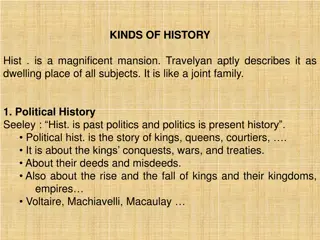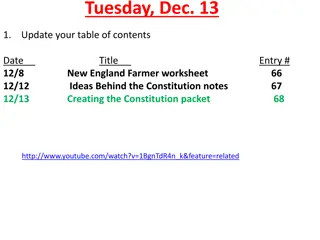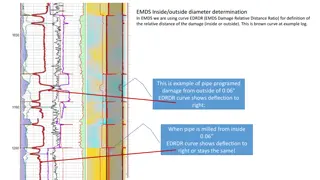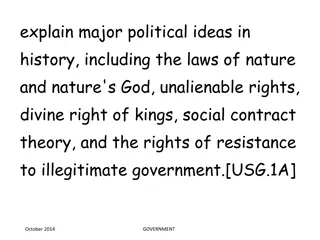
Compromises in US History: 1787, 1820, 1850, and 1877
Explore key compromises in US history including the Great Compromise of 1787, Compromise of 1820, Compromise of 1850, and Compromise of 1877, addressing issues like representation in Congress and the balance between free and slave states.
Download Presentation

Please find below an Image/Link to download the presentation.
The content on the website is provided AS IS for your information and personal use only. It may not be sold, licensed, or shared on other websites without obtaining consent from the author. If you encounter any issues during the download, it is possible that the publisher has removed the file from their server.
You are allowed to download the files provided on this website for personal or commercial use, subject to the condition that they are used lawfully. All files are the property of their respective owners.
The content on the website is provided AS IS for your information and personal use only. It may not be sold, licensed, or shared on other websites without obtaining consent from the author.
E N D
Presentation Transcript
The Great Compromise (1787) The issue: How would representation in Congress be determined? The views: Small State (NJ) Favored 1 house legislature, based on equal representation Large State (VA) Favored bicameral legislature, representation would be based on population The result: Bicameral (2-house) legislature One house would be based on population (House of Reps) One house would be equal representation (Senate)
The 3/5 Compromise (1787) The issue: How would slaves be counted towards representation in Congress? The views: North: Slaves should not count since they are not citizens South: Slaves should count since they are a large portion of population The result: 3/5 slaves (60%) will count towards representation in the House
Compromise of 1820 The issue: MO wanted enter union as a slave state Would upset the balance of free and slave Three aspects: Missouri would enter as a slave state Maine would enter as a free state (carved from MA) 3630 every future state above would be free, every state below would be slave The result: Increase sectional tensions between North and South Eventually overturned by Kansas-Nebraska Act
Compromise of 1850 The issue: What would happen to land gained from Mexican Cession? Would it be free or slave? Five Parts: Popular Sovereignty in Mexican Cession Fugitive Slave Law (more harsh) Abolition of slave trade in D.C. California is admitted as a free state Texas paid $10 for boundary dispute Significance: Avoided Civil War for 10 years Last hurrah for Great Triumvirate (Clay, Webster, Calhoun)
Compromise of 1877 VS The issue: Who won the presidential election of 1876 Tilden (Democrat) Hayes (Republican) Three states had conflicting electoral results (20 votes) Tilden needed only 1 The result: Hayes is declared the winner in return for: Removal of troops from the South (Reconstruction IS OVER!) Southerner must be named to Hayes cabinet $ to South
Thanks for watching! Subscribe to my channel Help spread the word Questions? Comments? Ideas for videos? Leave in comments Visit www.apushreview.com for many videos and resources






















